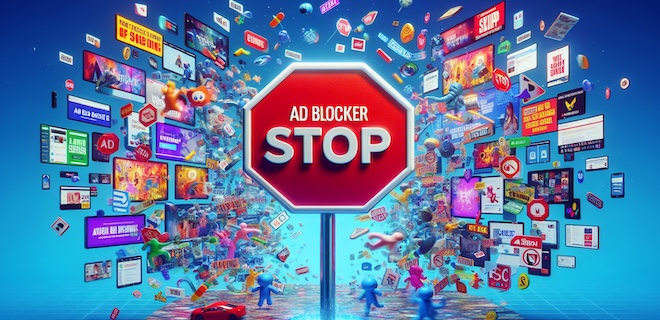
Despite adblocking no longer being seen as a critical issue, the rise of brutal adblockers has left publishers grappling with unmeasured dark traffic, revealing an untapped audience and new challenges for monetization.
Ad blocking was last decade’s big problem, right? It is no longer seen as an existential crisis; it’s become a back burner issue.
Why? Consumer adoption rates seemed to have slowed down. Mitigation solutions like Acceptable Ads and adblock walls took the revenue-hit sting out. A sense of hopelessness set in as many believed that they could achieve nothing more. Other looming crises—like signal loss and traffic loss—took center stage. It became a minor headache, easily ignored by popping an Acceptable Ads-laced aspirin.
Now, are you ready to take the red pill or the blue pill? If you take the blue pill, the story ends. You return to GAM and believe whatever you want to believe. If you take the red pill, you enter the blocked web, and I show you how deep the revenue hole goes.
The Red Pill
Let’s start with a hard fact. The majority of your adblocking audience is invisible to you. It does not appear in dashboards like Google Analytics, Adobe Analytics, or in-house reports. It doesn’t even show up in existing adblocking analytics. Off-grid.
This is dark traffic. You can’t see it. But it’s very much there.
We are talking about big numbers here. On average, 14-21% of a publisher’s total audience is uncaptured and unmeasured dark traffic. Put another way, the adblocking audience you are currently measuring is just 20-30% of what is actually there.
Sounds sinister? Yes and no. Dark traffic comprises regular people (not bots) accessing your website. People who buy stuff and have above-average disposable incomes. They are hidden from view because they are using a new generation of adblocking software that makes them undetectable by existing solutions in the marketplace.
This is great because you have an audience you didn’t know about. But it’s bad because it’s unmeasured and, even worse, unmonetized.
This new generation of adblocking software doesn’t just block analytics. It also blocks or doesn’t permit a bunch of other stuff that publishers have come to rely upon: Acceptable Ads, adblock walls, cookie-banners (CMPs), and in-house promotions (e.g., newsletter sign-ups). Because this new generation is so ruthless, we call them brutal adblockers.
The Cause of Dark Traffic
When folks in the industry talk about “adblockers” today, they refer to browser extensions like AdBlock and Adblock Plus. Owned by a company called eyeo, they became the dominant force that drove mainstream adblocking adoption from 2013-2019.
These adblockers are known for being somewhat hospitable to publishers, albeit for self-serving reasons. For example, eyeo set up Acceptable Ads, allowing publishers to run analytics, adblock walls, and cookie-banners. For this reason, we refer to them as soft adblockers.
Although soft adblockers have grown in usage, they have dramatically lost market share. In 2015, AdBlock and Adblock Plus commanded 80%+ of adblocked page views online. Today, it’s in the region of 25-30%. Therefore, this is the ratio of your adblocked audience that will see Acceptable Ads.
What generates the other 70%+? You guessed it: brutal adblockers that cause dark traffic. There are now 700m+ users globally. Much of this has materialized in the years since COVID-19—the open web’s inconvenient truth.
Who Are the Brutal Adblockers?
When I talk to publishers about this, one of the questions I get asked is, ‘Who are the brutal adblockers?’ If eyeo via Adblock and Adblock Plus isn’t ruling the roost anymore, who is?
Well, it’s not so much a single who, but many players. The adblocking software market has become fragmented. Many companies are getting a slice of the action, offering adblocking through various types of products (it’s no longer mainly limited to browser extensions).
Adblocking software is available through built-in browsers, operating system applications, VPNs, and at the network level. Hundreds of providers exist across these categories, with popular examples being AdGuard, uBlock Origin, and Brave.
Most of these providers are brutal adblockers, having found eager user bases dissatisfied with the approach and limitations of AdBlock and Adblock Plus.
Collectively, they’re an unacknowledged audience.
The Brutal Adblocker Era
It’s time to acknowledge that we are in a new era. An era where the terms of the adblockers themselves have fundamentally changed. eyeo, through AdBlock and Adblock Plus, is no longer the main stakeholder and intermediary to which publishers can reach a value exchange compromise with adblocking users. Nor are other methodologies, like adblock walls, effective if blocked.
It’s time to think about adblocking differently. Publishers should build a direct relationship with users of brutal adblocking software and reintroduce a sustainable monetization mechanism.
Realistically, micropayments and subscriptions aren’t going to work for most publishers. The only viable option is to reintroduce ads, using resilient ad delivery that doesn’t get blocked. Today, it is possible to do this—to restore a publisher’s ad stack to brutal adblocking users with ads that users find agreeable and user-centric.
That may sound like a contradiction, but it is not. As eyeo has proven with Acceptable Ads for its soft adblockers, users do not have binary preferences: ads or no ads. Instead, they are open to seeing non-interruptive ads if those are the terms presented to them.
Brutal adblocking users are no different. There’s a clear distinction between the software and the people using it. One is not reflective of the other. While brutal adblocking software is extreme to the extent of what it blocks on publisher websites, its users are regular people. They’re not fanatics. They’re teachers, accountants, students, and doctors. Sometimes, they are using a brutal adblocker by default (e.g., it runs on their employer’s network), and sometimes, it’s because they can (spoiler: most people would rather not see ads if that’s an option).
Publishers that can directly control the terms of their advertising experience while preserving their readers’ preferences and trust will win.
